STREET OF SHAME (AKASEN CHITAI) (Kenji Mizoguchi, 1956)
Film Forum
209 West Houston St.
Saturday, April 16, 1:00, 4:30, 8:00
Series continues through April 21
212-727-8110
www.filmforum.org
 Made the same year Japan passed a major anti-prostitution law, Kenji Mizoguchi’s final film, 1956’s Street of Shame, is a brutally honest depiction of the decidedly unglamorous life of a group of courtesans at a Tokyo brothel. “Yoshiwara has been here three hundred years,” the Mamasan (Sadako Sawamura) says early on to a police officer. “Does an unnecessary business last so long?” Originally titled Red-Light District, the black-and-white film features an outstanding cast of women playing desperate geisha with serious family and financial problems that lead them to the embarrassment of trying to physically force men off the dark, dank street and into their rooms. Hanae (Michiyo Kogure) has to deal with aging, a baby, and a suicidal husband, Yumeko (Aiko Mimasu) doesn’t want her son to know what she does to earn money to attempt to give him a decent life, Yorie (Hiroko Machida) thinks a husband in a faraway village will gain her longed-for freedom, Yasumi (Ayako Wakao) has become a loan shark to her coworkers, and young Mickey (Machiko Kyō) is quick to share her opinions about the other women but not so quick to catch on to the debasement she is lowering herself to. The protofeminist director of such previous works as Sisters of the Gion, Osaka Elegy, Women of the Night, and The Life of Oharu as well as the brilliant two-part samurai epic The 47 Ronin, Mizoguchi spent much of his career — which included more than seventy films in thirty-three years, up to his death in 1956 at the age of fifty-eight — making films about the exploitation of women, partly influenced by having seen his sister sold into prostitution by their father. It’s a shame that Street of Shame, one of Mizoguchi’s best, also turned out to be his last, but what a way to go. Street of Shame is screening April 16 with Keisuke Kinoshita’s Carmen Comes Home (1951) as part of Film Forum’s “5 Japanese Divas” series, four weeks of films starring Kyo, Isuzu Yamada, Tanaka, Machiko Kyo, Setsuko Hara, and Hideko Takamine, who play strong, determined women in such classic works as Ozu’s Early Summer (1951) and Tokyo Story (1953), Hiroshi Teshigahara’s The Face of Another (1966), Mikio Naruse’s Okaasan (1952) and Flowing (1956), Akira Kurosawa’s The Idiot (1951) and Throne of Blood (1957), Kinoshita’s Twenty-Four Eyes (1954), and Mizoguchi’s Ugetsu (1953) and Sansho the Bailiff (1954), among others.
Made the same year Japan passed a major anti-prostitution law, Kenji Mizoguchi’s final film, 1956’s Street of Shame, is a brutally honest depiction of the decidedly unglamorous life of a group of courtesans at a Tokyo brothel. “Yoshiwara has been here three hundred years,” the Mamasan (Sadako Sawamura) says early on to a police officer. “Does an unnecessary business last so long?” Originally titled Red-Light District, the black-and-white film features an outstanding cast of women playing desperate geisha with serious family and financial problems that lead them to the embarrassment of trying to physically force men off the dark, dank street and into their rooms. Hanae (Michiyo Kogure) has to deal with aging, a baby, and a suicidal husband, Yumeko (Aiko Mimasu) doesn’t want her son to know what she does to earn money to attempt to give him a decent life, Yorie (Hiroko Machida) thinks a husband in a faraway village will gain her longed-for freedom, Yasumi (Ayako Wakao) has become a loan shark to her coworkers, and young Mickey (Machiko Kyō) is quick to share her opinions about the other women but not so quick to catch on to the debasement she is lowering herself to. The protofeminist director of such previous works as Sisters of the Gion, Osaka Elegy, Women of the Night, and The Life of Oharu as well as the brilliant two-part samurai epic The 47 Ronin, Mizoguchi spent much of his career — which included more than seventy films in thirty-three years, up to his death in 1956 at the age of fifty-eight — making films about the exploitation of women, partly influenced by having seen his sister sold into prostitution by their father. It’s a shame that Street of Shame, one of Mizoguchi’s best, also turned out to be his last, but what a way to go. Street of Shame is screening April 16 with Keisuke Kinoshita’s Carmen Comes Home (1951) as part of Film Forum’s “5 Japanese Divas” series, four weeks of films starring Kyo, Isuzu Yamada, Tanaka, Machiko Kyo, Setsuko Hara, and Hideko Takamine, who play strong, determined women in such classic works as Ozu’s Early Summer (1951) and Tokyo Story (1953), Hiroshi Teshigahara’s The Face of Another (1966), Mikio Naruse’s Okaasan (1952) and Flowing (1956), Akira Kurosawa’s The Idiot (1951) and Throne of Blood (1957), Kinoshita’s Twenty-Four Eyes (1954), and Mizoguchi’s Ugetsu (1953) and Sansho the Bailiff (1954), among others.
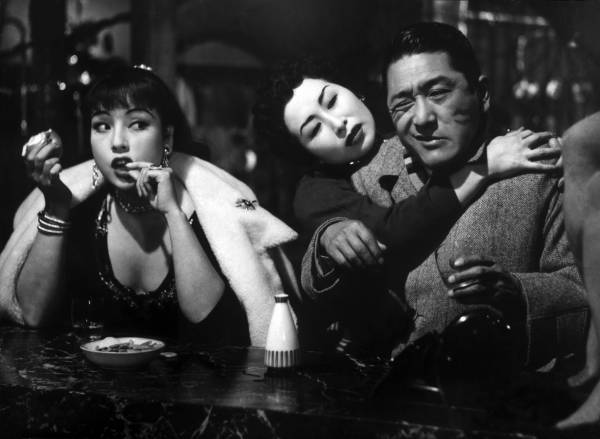

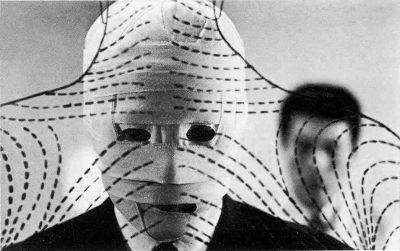
 Kôbô Abe and director Hiroshi Teshigahara collaborated on five films together, including the marvelously existential Woman of the Dunes in 1964 and The Face of Another two years later. In The Face of Another, Tatsuya Nakadai (The Human Condition, Kill!) stars as Okuyama, a man whose face has virtually disintegrated in a laboratory accident. He spends the first part of the film with his head wrapped in bandages, a la the Invisible Man, as he talks about identity, self-worth, and monsters with his wife (Machiko Kyo), who seems to be growing more and more disinterested in him. Then Okuyama visits a psychiatrist (Mikijirô Hira) who is able to create a new face for him, one that would allow him to go out in public and just become part of the madding crowd again. But his doctor begins to wonder, as does Okuyama, whether the mask has actually taken control of his life, making him as helpless as he was before. Abe’s remarkable novel is one long letter from Okuyama to his wife, filled with utterly brilliant, spectacularly detailed examinations of what defines a person and his or her value in society. Abe wrote the film’s screenplay, which tinkers with the time line and creates more situations in which Okuyama interacts with people; although that makes sense cinematically, much of Okuyama’s interior narrative, the building turmoil inside him, gets lost. Teshigahara once again uses black and white, incorporating odd cuts, zooms, and freeze frames, amid some truly groovy sets, particularly the doctor’s trippy office, and Tōru Takemitsu’s score is ominously groovy as well. As a counterpart to Okuyama, the film also follows a young woman (Miki Irie) with one side of her face severely scarred; she covers it with her hair and is not afraid to be seen in public, while Okuyama must hide behind a mask. But as Abe points out in both the book and the film, everyone hides behind a mask of one kind or another. The Face of Another is screening April 7 as part of Film Forum’s “5 Japanese Divas” series, featuring four weeks of films starring Kyo, Isuzu Yamada, Kimuyo Tanaka, Setsuko Hara, and Hideko Takamine, who play strong, determined women in such classic works as Yasujiro Ozu’s Early Summer (1951) and Tokyo Story (1953), Hiroshi Teshigahara’s The Face of Another (1966), Mikio Naruse’s Okaasan (1952) and Flowing (1956), Akira Kurosawa’s The Idiot (1951) and Throne of Blood (1957), Keisuke Kinoshita’s Carmen Comes Home (1951) and Twenty-Four Eyes (1954), and Kenji Mizoguchi’s Ugetsu (1953), Sansho the Bailiff (1954), and Street of Shame (1956), among others.
Kôbô Abe and director Hiroshi Teshigahara collaborated on five films together, including the marvelously existential Woman of the Dunes in 1964 and The Face of Another two years later. In The Face of Another, Tatsuya Nakadai (The Human Condition, Kill!) stars as Okuyama, a man whose face has virtually disintegrated in a laboratory accident. He spends the first part of the film with his head wrapped in bandages, a la the Invisible Man, as he talks about identity, self-worth, and monsters with his wife (Machiko Kyo), who seems to be growing more and more disinterested in him. Then Okuyama visits a psychiatrist (Mikijirô Hira) who is able to create a new face for him, one that would allow him to go out in public and just become part of the madding crowd again. But his doctor begins to wonder, as does Okuyama, whether the mask has actually taken control of his life, making him as helpless as he was before. Abe’s remarkable novel is one long letter from Okuyama to his wife, filled with utterly brilliant, spectacularly detailed examinations of what defines a person and his or her value in society. Abe wrote the film’s screenplay, which tinkers with the time line and creates more situations in which Okuyama interacts with people; although that makes sense cinematically, much of Okuyama’s interior narrative, the building turmoil inside him, gets lost. Teshigahara once again uses black and white, incorporating odd cuts, zooms, and freeze frames, amid some truly groovy sets, particularly the doctor’s trippy office, and Tōru Takemitsu’s score is ominously groovy as well. As a counterpart to Okuyama, the film also follows a young woman (Miki Irie) with one side of her face severely scarred; she covers it with her hair and is not afraid to be seen in public, while Okuyama must hide behind a mask. But as Abe points out in both the book and the film, everyone hides behind a mask of one kind or another. The Face of Another is screening April 7 as part of Film Forum’s “5 Japanese Divas” series, featuring four weeks of films starring Kyo, Isuzu Yamada, Kimuyo Tanaka, Setsuko Hara, and Hideko Takamine, who play strong, determined women in such classic works as Yasujiro Ozu’s Early Summer (1951) and Tokyo Story (1953), Hiroshi Teshigahara’s The Face of Another (1966), Mikio Naruse’s Okaasan (1952) and Flowing (1956), Akira Kurosawa’s The Idiot (1951) and Throne of Blood (1957), Keisuke Kinoshita’s Carmen Comes Home (1951) and Twenty-Four Eyes (1954), and Kenji Mizoguchi’s Ugetsu (1953), Sansho the Bailiff (1954), and Street of Shame (1956), among others.
 Based on the Russian novel Yama (The Pit) by Aleksandr Kuprin, protofeminist director Kenji Mizoguchi’s Sisters of the Gion offers a poignant look at the changing desires of women in twentieth-century Japan. In the Gion District, geisha have become one-man prostitutes, taking up with one wealthy patron at a time. When Furusawa (Benkei Shiganoya) loses his business, the bankrupt man turns away from his wife and instead goes to Umekichi (Yōko Umemura), who takes him in, believing that it is her responsibility. Her younger sister, Omocha (Isuzu Yamada), is furious, arguing that geisha, and women in general, should be more than just the playthings of men. She wants her sister instead to find a rich patron who can take care of her in style. Omocha is a manipulative woman, willing to lie to get what she thinks she and Umekichi deserve, but she is not doing it for evil reasons as much as she wants to change the plight of the geisha and give more power to women. But Umekichi cannot break free of the old-fashioned ways as Omocha plays games with successful businessman Jurakudo (Fumio Okura) and his assistant, Kimura (Taizō Fukami), devising a plot that threatens to tear everything apart. Mizoguchi fills Sisters of the Gion with long shots of narrow passageways as characters try to escape from their situations but are unable to. Made in 1936, just before a war that would change Japan’s views on houses of ill repute, the film is virtually timeless for most of its too-brief sixty-nine minutes, until one man decides to take actions into his own hands and suddenly cars and the nearby city shift the overall perspective. In the end, it’s about more than just money, although it’s definitely about that, but it’s also about respect, about common decency, and about humanity, as seen from all sides. Sisters of the Gion is screening April 4 with Yasujiro Ozu’s 1933 silent crime drama, Dragnet Girl, starring Kinuyo Tanaka, as part of Film Forum’s “5 Japanese Divas” series, featuring four weeks of films starring Yamada, Tanaka, Machiko Kyo, Setsuko Hara, and Hideko Takamine, who play strong, determined women in such classic works as Ozu’s Early Summer (1951) and Tokyo Story (1953), Hiroshi Teshigahara’s The Face of Another (1966), Mikio Naruse’s Okaasan (1952) and Flowing (1956), Akira Kurosawa’s The Idiot (1951) and Throne of Blood (1957), Keisuke Kinoshita’s Carmen Comes Home (1951) and Twenty-Four Eyes (1954), and Mizoguchi’s Ugetsu (1953), Sansho the Bailiff (1954), and Street of Shame (1956), among others.
Based on the Russian novel Yama (The Pit) by Aleksandr Kuprin, protofeminist director Kenji Mizoguchi’s Sisters of the Gion offers a poignant look at the changing desires of women in twentieth-century Japan. In the Gion District, geisha have become one-man prostitutes, taking up with one wealthy patron at a time. When Furusawa (Benkei Shiganoya) loses his business, the bankrupt man turns away from his wife and instead goes to Umekichi (Yōko Umemura), who takes him in, believing that it is her responsibility. Her younger sister, Omocha (Isuzu Yamada), is furious, arguing that geisha, and women in general, should be more than just the playthings of men. She wants her sister instead to find a rich patron who can take care of her in style. Omocha is a manipulative woman, willing to lie to get what she thinks she and Umekichi deserve, but she is not doing it for evil reasons as much as she wants to change the plight of the geisha and give more power to women. But Umekichi cannot break free of the old-fashioned ways as Omocha plays games with successful businessman Jurakudo (Fumio Okura) and his assistant, Kimura (Taizō Fukami), devising a plot that threatens to tear everything apart. Mizoguchi fills Sisters of the Gion with long shots of narrow passageways as characters try to escape from their situations but are unable to. Made in 1936, just before a war that would change Japan’s views on houses of ill repute, the film is virtually timeless for most of its too-brief sixty-nine minutes, until one man decides to take actions into his own hands and suddenly cars and the nearby city shift the overall perspective. In the end, it’s about more than just money, although it’s definitely about that, but it’s also about respect, about common decency, and about humanity, as seen from all sides. Sisters of the Gion is screening April 4 with Yasujiro Ozu’s 1933 silent crime drama, Dragnet Girl, starring Kinuyo Tanaka, as part of Film Forum’s “5 Japanese Divas” series, featuring four weeks of films starring Yamada, Tanaka, Machiko Kyo, Setsuko Hara, and Hideko Takamine, who play strong, determined women in such classic works as Ozu’s Early Summer (1951) and Tokyo Story (1953), Hiroshi Teshigahara’s The Face of Another (1966), Mikio Naruse’s Okaasan (1952) and Flowing (1956), Akira Kurosawa’s The Idiot (1951) and Throne of Blood (1957), Keisuke Kinoshita’s Carmen Comes Home (1951) and Twenty-Four Eyes (1954), and Mizoguchi’s Ugetsu (1953), Sansho the Bailiff (1954), and Street of Shame (1956), among others.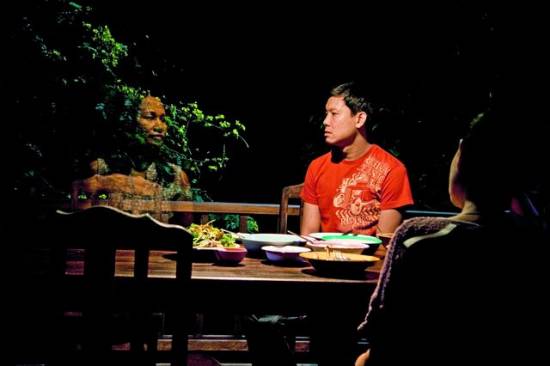
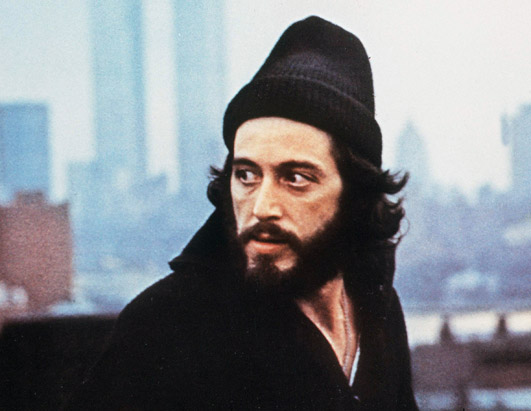
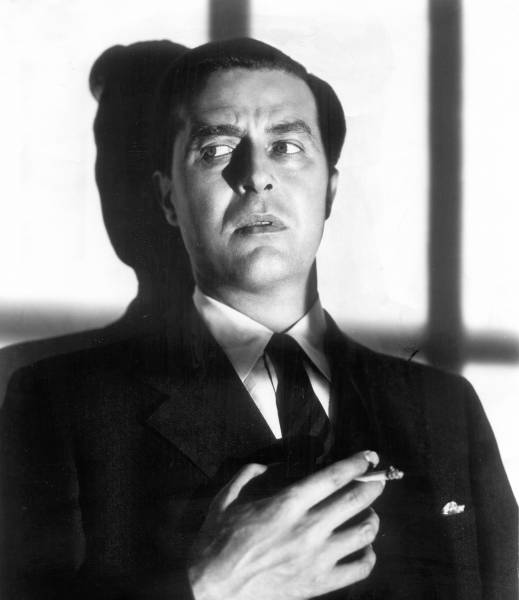
 Based on the 1943 novel by Graham Greene, Fritz Lang’s MINISTRY OF FEAR is a classic Hitchcockian noir about an innocent man caught up in a dangerous web of mystery and intrigue. Ray Milland stars as Stephen Neale, a man who, as the film opens, is being released from an asylum after serving time related to the death of his wife. His freedom doesn’t last long, as he stops at a local fair and visits the fortune-teller, who accidentally helps him win a guess-the-weight cake that some very bad people want to get their hands in. Out on the run, his only friends are Willi (Carl Esmond) and Carla (Marjorie Reynolds), foreign siblings who run the charity organization the Mothers of Free Nations, the sponsor of the fair. Throw in a séance, the Blitz, an old blind man, an alcoholic private investigator, a book called THE PSYCHOLOGY OF NAZISM, a disbelieving Scotland Yard detective, and wonderfully shadowy camerawork and the result is a tense, exciting spy tale filled with plenty of twists and surprises. MINISTRY OF FEAR is screening with Lang’s 1941 thriller MAN HUNT, starring Joan Bennett and Walter Pidgeon, as part of Film Forum’s Fritz Lang in Hollywood series, which continues through February 10 with such other great twin bills as CLASH BY NIGHT (1952) and RANCHO NOTORIOUS (1952) on February 6-7 and YOU ONLY LIVE ONCE (1937) and YOU AND ME (1938) on February 9-10.
Based on the 1943 novel by Graham Greene, Fritz Lang’s MINISTRY OF FEAR is a classic Hitchcockian noir about an innocent man caught up in a dangerous web of mystery and intrigue. Ray Milland stars as Stephen Neale, a man who, as the film opens, is being released from an asylum after serving time related to the death of his wife. His freedom doesn’t last long, as he stops at a local fair and visits the fortune-teller, who accidentally helps him win a guess-the-weight cake that some very bad people want to get their hands in. Out on the run, his only friends are Willi (Carl Esmond) and Carla (Marjorie Reynolds), foreign siblings who run the charity organization the Mothers of Free Nations, the sponsor of the fair. Throw in a séance, the Blitz, an old blind man, an alcoholic private investigator, a book called THE PSYCHOLOGY OF NAZISM, a disbelieving Scotland Yard detective, and wonderfully shadowy camerawork and the result is a tense, exciting spy tale filled with plenty of twists and surprises. MINISTRY OF FEAR is screening with Lang’s 1941 thriller MAN HUNT, starring Joan Bennett and Walter Pidgeon, as part of Film Forum’s Fritz Lang in Hollywood series, which continues through February 10 with such other great twin bills as CLASH BY NIGHT (1952) and RANCHO NOTORIOUS (1952) on February 6-7 and YOU ONLY LIVE ONCE (1937) and YOU AND ME (1938) on February 9-10.